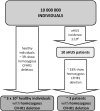Complement factor H-related protein 1 deficiency and factor H antibodies in pediatric patients with atypical hemolytic uremic syndrome
- PMID: 23243267
- PMCID: PMC3586960
- DOI: 10.2215/CJN.01260212
Complement factor H-related protein 1 deficiency and factor H antibodies in pediatric patients with atypical hemolytic uremic syndrome
Abstract
Background and objectives: This study evaluated the relevance of complement factor H (CFH)-related protein (CFHR) 1 deficiency in pediatric patients with atypical hemolytic uremic syndrome (aHUS) by evaluating both the frequency of deletions in CFHR1 and the presence of complement factor H (CFH) antibodies.
Design, setting, participants, & measurements: A total of 116 patients (mainly from central Europe) and 118 healthy blood donors were included from 2001 to 2012. The presence of CFHR1 gene deletions was determined in 90 pediatric patients with aHUS and 118 controls by an easy, fast, and cheap PCR assay; 100 patients with aHUS and 42 controls were tested for CFH antibodies by ELISA. Questionnaires were administered to evaluate the clinical and laboratory data.
Results: Homozygous deletion in CFHR1 was detected in 32% of the patients with aHUS tested, compared with 2.5% of controls (P<0.001). CFH antibodies were present in 25% of the patients and none of the controls. CFH antibodies were detected in 82% of patients with homozygous CFHR1 gene deletion and in 6% of patients without. CFH antibody-positive patients with aHUS showed a significantly lower platelet nadir at disease onset and significantly less frequent involvement of the central nervous system than did antibody-negative patients. Antibody-positive patients also received plasma therapy more often.
Conclusion: Homozygous deletion in CFHR1 is strongly associated with occurrence of CFH antibodies in pediatric patients with aHUS. However, despite this apparent genetic disease predisposition, it cannot be considered an exclusive cause for aHUS. Initial presentation of Shiga toxin-negative HUS with severe thrombocytopenia and no central nervous system complications in pediatric patients is especially suspicious for CFH antibody aHUS.
Figures



References
-
- Rosales A, Hofer J, Zimmerhackl LB, Jungraithmayr TC, Riedl M, Giner T, Strasak A, Orth-Höller D, Würzner R, Karch H, German-Austrian HUS Study Group : Need for long-term follow-up in enterohemorrhagic Escherichia coli-associated hemolytic uremic syndrome due to late-emerging sequelae. Clin Infect Dis 54: 1413–1421, 2012 - PubMed
-
- Scheiring J, Pruefer F, Martini S, Wygoda S, Knueppel T, Toenshoff B, Konrad M, Drube J, Offner G, Zipfel P, Heinen S, Kirschfink M, Zimmerhackl LB: Updated outcome in patients with a typical/recurrent haemolytic uraemic syndrome. Pediatr Transplant 11: 82, 2007 - PubMed
-
- Besbas N, Karpman D, Landau D, Loirat C, Proesmans W, Remuzzi G, Rizzoni G, Taylor CM, Van de Kar N, Zimmerhackl LB, European Paediatric Research Group for HUS : A classification of hemolytic uremic syndrome and thrombotic thrombocytopenic purpura and related disorders. Kidney Int 70: 423–431, 2006 - PubMed
-
- Sellier-Leclerc AL, Fremeaux-Bacchi V, Dragon-Durey MA, Macher MA, Niaudet P, Guest G, Boudailliez B, Bouissou F, Deschenes G, Gie S, Tsimaratos M, Fischbach M, Morin D, Nivet H, Alberti C, Loirat C, French Society of Pediatric Nephrology : Differential impact of complement mutations on clinical characteristics in atypical hemolytic uremic syndrome. J Am Soc Nephrol 18: 2392–2400, 2007 - PubMed
-
- Zimmerhackl LB, Scheiring J, Prüfer F, Taylor CM, Loirat C: Renal transplantation in HUS patients with disorders of complement regulation. Pediatr Nephrol 22: 10–16, 2007 - PubMed
Publication types
MeSH terms
Substances
LinkOut - more resources
Full Text Sources
Research Materials
Miscellaneous

